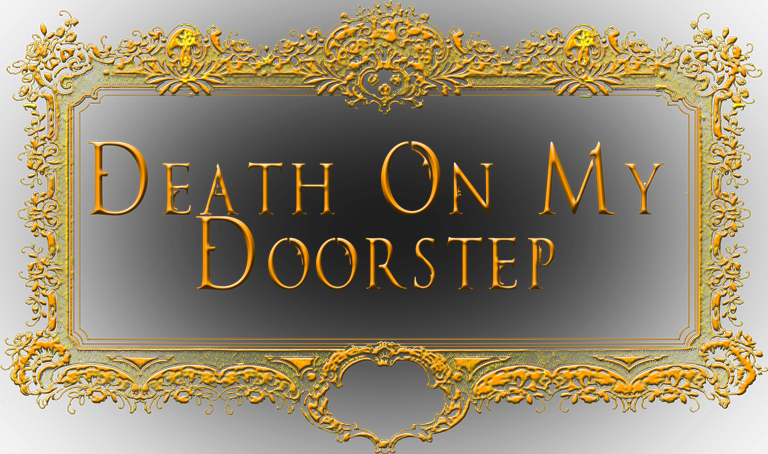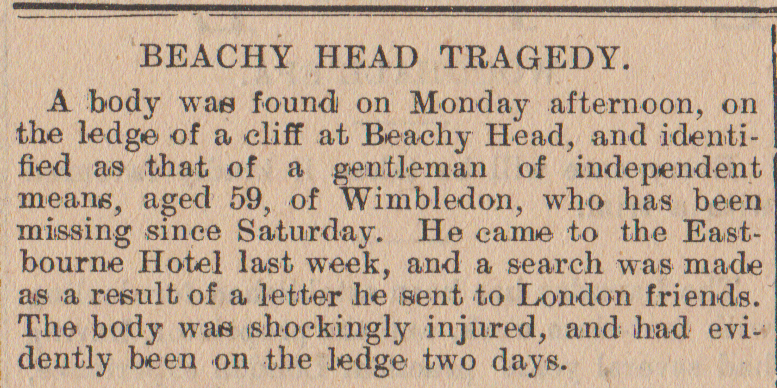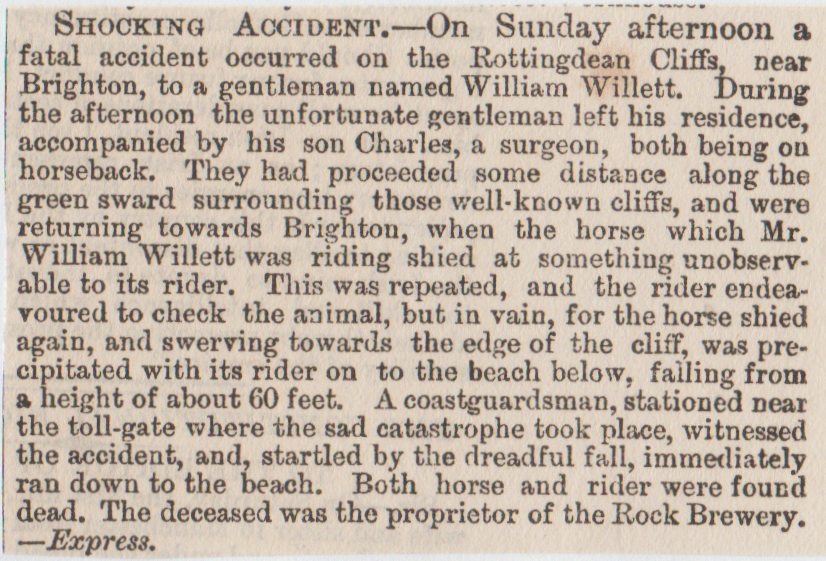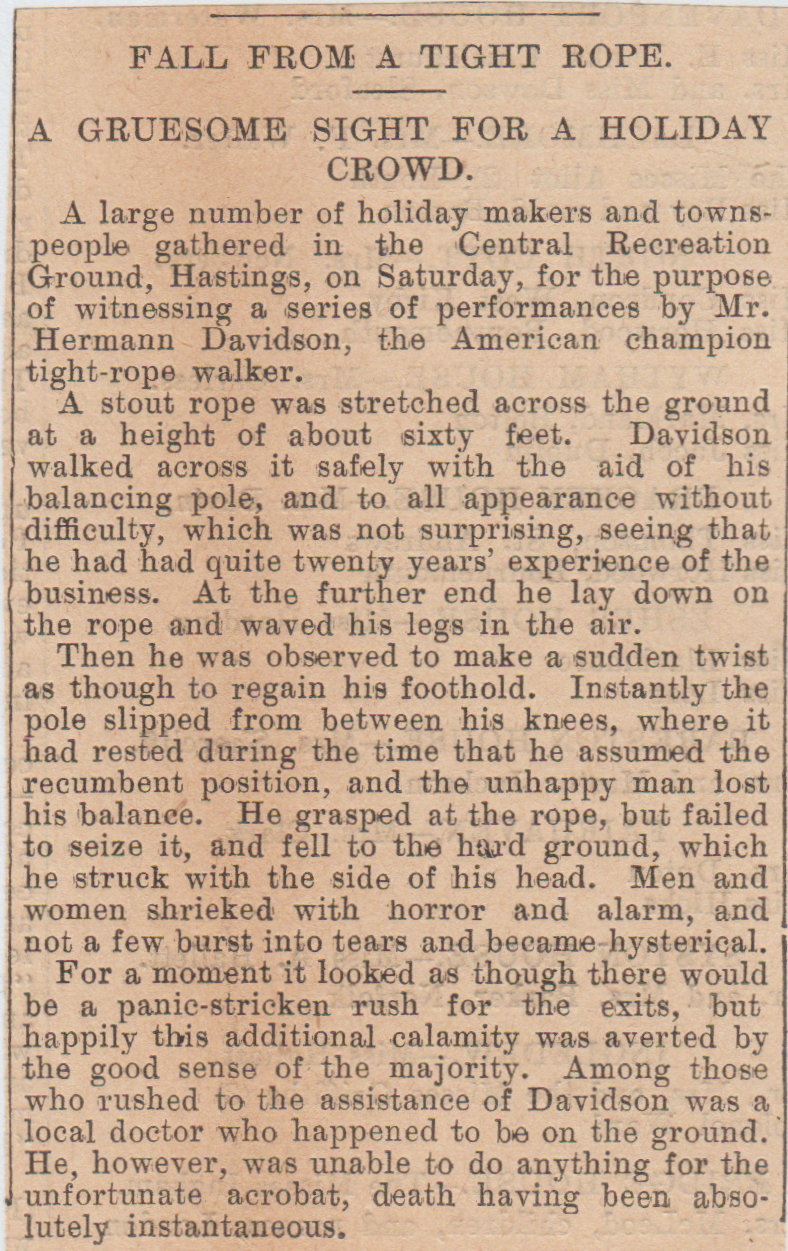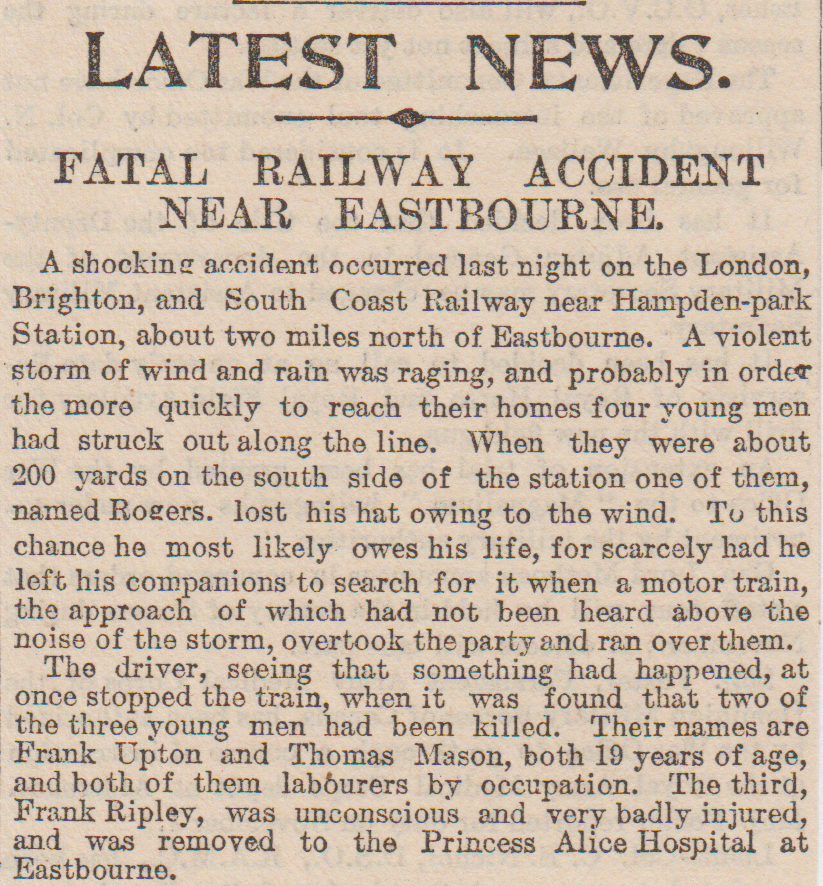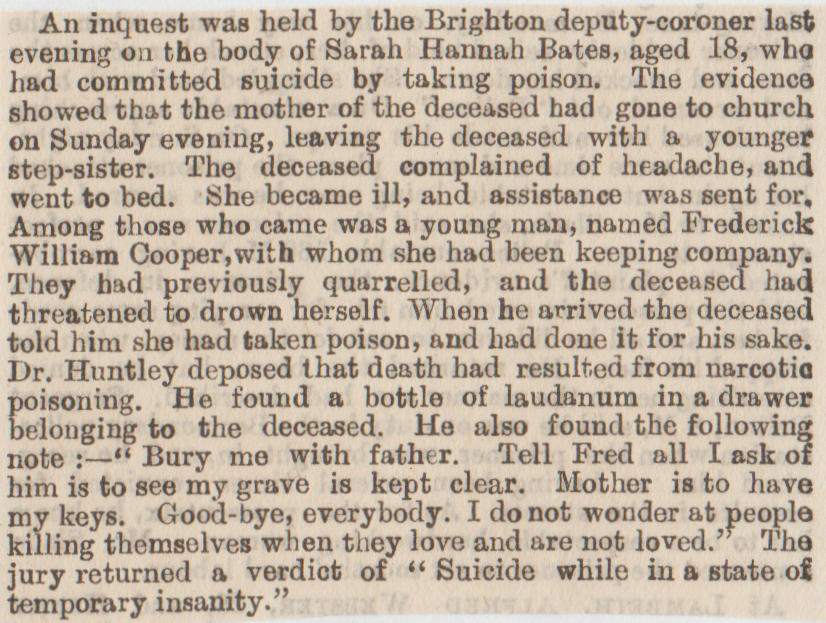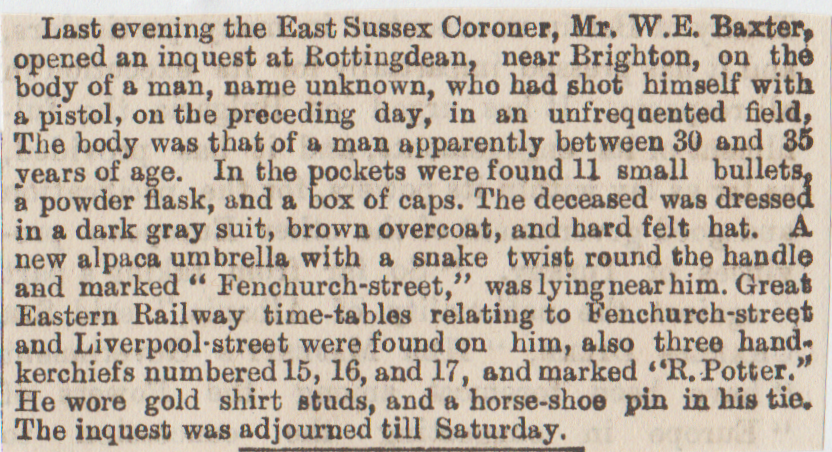1/ Falmer Churchyard Suicide, January 1878

William Jackson shot himself in the above churchyard. Here’s his suicide note:
“Friends, dear parents and sisters, -I have journeyed on cheerfully till now, when the thought comes upon me of the immense anxieties of my friends concerning my future punishment, so that I decided to put an end to my existence, and release you, however painfully, of the contemplation of my awful condition. The strain upon my dear mother’s nerves was terrible to think of. There are many keepers about here, and I shall wait for one to seize his gun from the corner of the public-house & shoot myself. I feel the writing of this much more than I shall the act, and it is for your own good. I sadly fear I have mistaken my vocation in life. Please excuse me if I do not write in an affectionate strain as it would unman? me. Hamburger, I do not think he will continue telling such a tale upon my death. It was a fair duel, a long and severe quarrel. He had libelled me, and I was determined to be avenged. I drew part of the powder from the cartridge and did not think it would kill. I asked him which he would have, the dagger or pistol, and he said dagger. I threw it to the other end of the room, and when he rushed to pick it up, I fired.I then closed with him, and after a terrible struggle wrested the dagger from him, and threw him off. I repeated my act and asked to make terms. He offered me a sovereign to go, but I did not ask or wish for money. I said if he allowed me half an hour’s start I would leave him. He promised not to pursue or prosecute me, so I threw down my Knife and ran. He picked it up and followed me down the first flight. I made a stand, when he at once returned to the room. I ran down Andrew Street, jumped in a cab, and drove to Westminster.”
He also wanted to be buried where he was christened, as a last wish!
2/ Bodiam Castle Suicide, October 1897

Miss Elizabeth Dixon Simpson, fifty-two years of age, had recently been an inmate of the lunatic asylum at Rockhampton. She was released and went to stay with Reverend Theodore Johnson, vicar of Bodiam, at the vicarage. One Sunday while everyone was at church she trekked up to the castle and vanished. People looked high and low in the surrounding area, but it wasn’t until the castle moat was dragged that her body floated up to the surface. “Suicide while of unsound mind”.
3/ Beachy Head, East Sussex, May 1850
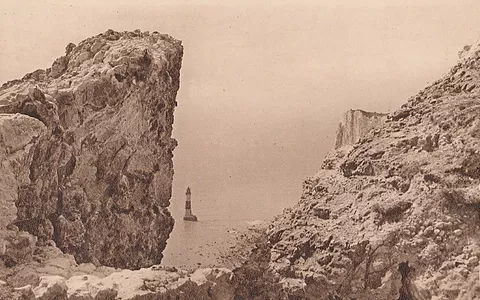
A sad accident occurred on what is primarily England’s suicide capital (A lot more later on).This accident involved the Reverend Henry James, Vicar of Willingdon, who took his daughter and another vicar from Levington, Henry Watson on a walk along the cliffs and beach. James was wanting to climb the rocks, but Watson wasn’t so keen, so while James descended Watson told the daughter to stay at the top. James, being a spritely 38-year-old, carried on down all the while calling to each other. Then there was silence. Watson called out and a reply came “For God’s sake, don’t come; I have hurt myself very much”. The two scrambled to get the coast-guard and when they located the spot there was his body lying on the sand, with blood oozing from his nose and mouth. It judged to be a case of “Accidental Death”.
Beachy Head Suicides/ Deaths.
4/ July 1892- The body of a man was discovered at Fort Beachy Head, it was terribly mangled. There was a letter on the body which stated that he intended to throw himself from a cliff which is over five-hundred feet high. He was identified as E.W.Smith, Claremont, Windsor, so had travelled especially to this spot for the purpose of self-destruction.
5/ August 1885- Jane Green was charged with having deserted her child, which was found dead in a meadow between Eastbourne and Beachy Head. The child was wrapped in some Birmingham newspapers and when police found the exact same papers in Green’s room, she was immediately arrested.
6/ June 1905- A man in his late fifties or early sixties was seen to fall off Beachy Head. Coastguards and police searched the area and found the corpse on the beach. The only clue to his identity was his underclothing marked with the name of “C.J.Page”.
7/ Beachy Head Suicide, September 1906
8/ Pevensey Castle Death, May 1896
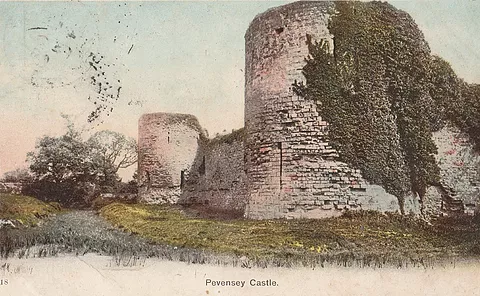
11-year-old John Wilton Allen from Bexhill was enjoying a visit to Pevensey Castle with his Dad and brother, when going under the arch he ran and jumped, with the idea of catching on to the keystone (centre stone of arch). The stone gave way and it flattened the lad’s skull. It was the property of The Duke of Devonshire and because of free entry, no guarantees of safety could be assured. The stone which fell on him was about six or seven stones in weight and hundreds of years old. A few years previously a young boy fell off a wall and was killed, so the notices around Pevensey were ignored by the public, on the whole.
9/ Bodiam Castle Death, July 1901
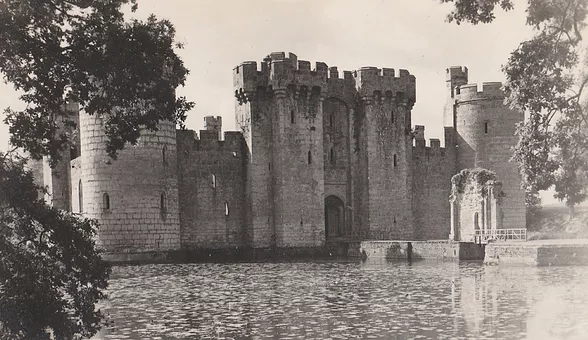
A group of day-trippers from Hawkshurst Nonconformist places of worship were visiting Bodiam Castle, when a member of the group, Fred Weller, climbed up the central tower of the ruins despite being told by staff not to, due to the crumbling brickwork it was deemed unsafe. While he was on the parapet of the tower when a portion of masonry crumbled from underneath him and he fell on to the lead roof of the armoury. Weller landed on one of the ladies who was below and she sustained serious injuries, but he suffered a fractured skull and broken legs.
10/ Wookeys Hotel Suicide, Ratton (Eastbourne) July 1846
A gentleman by the alias, Wilson, went to stay at Wookeys Hotel in Ratton and was there for six months, eating and drinking there, but the owner, Mr Wookey, never once asked him to settle up. When he first arrived he told Mr Wookey that he was from noble stock and had come to purchase land, but after six months of “extracting the urine”, he asked for some cash as he owed him approximately £70,(a huge amount in those days). “All right,” said Wilson,”I’ll ring the bell when I’m ready” and went upstairs to get him the money, then the bell rang and Wookey went up and heard a loud report from Wilson’s room. When his belongings were searched it was found that no money was present, but a load of begging letters to close friends and relatives.
11/ Brighton Suicide, November 1872
Opposite the Bristol Hotel in Brighton, a crudely made wooden box tied with rope was thrown by the sea on the beach. When police opened it, it was found to contain the body of a man in his late-twenties with trousers and a shirt on. The face and head had signs bruising and a thigh was broken. The surgeon stated that he’d been dead less than a day and tied to the box was a bag of coal, which presumably was meant to weigh it down. The body remains a John Doe but could be that of a missing tradesman from the local area. (Who was it in the end?)
12/ Danehill Parish Church Suicide, April 1901
Thirty-one-year-old Spencer Wood, a local bricklayer, was found hanging in the stokehole of Danehill Parish Church. He was hanging by his handkerchief, which was attached to a hot water pipe. He had been suffering from influenza.
13/ Hailsham Shooting Fatality, May 1899
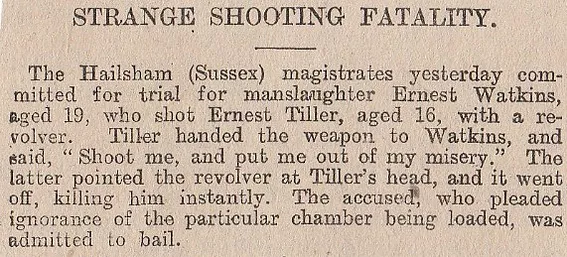
14/ Cavendish Hotel, Eastbourne, September 1896 (Head Squashed by Lift)
An engineer at the Cavendish Hotel in Eastbourne has met with an appalling accident. The unnamed man was working on the hydraulic lift, when his head was crushed, resulting in his inimitable death.
15/ Eastbourne Pier, (Children’s Bodies Dumped) December 1891
The corpses of two little children were discovered wrapped in a parcel and discarded near to the rocks at Eastbourne Pier.
16/ Lewes Accidental Poisoning, December 1842
A dreadful error at the chemists has cost a lady her life, in the Sussex town of Lewes. Twenty-four-year-old Sarah Nash was feeling very ill, so she asked him to go to Mr Martin’s Chemist in the Cliff, for a shilling’s worth of “black draught”. The chemist thought the bloke had said “black drop” and passed him something completely different. Asked by the chemist if he knew how to use it, he nodded and walked out of the shop. He gave his missus a dose of the poison and not unsurprisingly, she died soon after. A verdict of “Accidental death”
17/ Patcham Railway Tunnel Suicide, near Brighton, September 1895
A young man’s mutilated remains were found in Patcham Railway Tunnel, a few miles from Brighton. The body was identified as that Harry Gunn aged twenty-six. Only last week another young man killed himself in the exact same spot.
18/ Hove Child Murder, September 1906
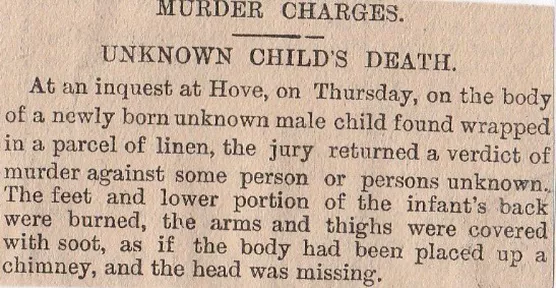
19/ Brighton Railway Station Suicide, June 1869
Frances Jane Bray aged twenty-four killed herself at Brighton Railway Station by leaping in front of a train. Bray was heavily pregnant when she did this and a carriage cleaner named Gould actually saw her milling about one of the lines. He shouted out and then was on his way to have a word with her when she dived in front of a tender and break. A porter named Pellatt ran forward and pushed her back and the wheels cleared her. Unfortunately, she was in a determined mood to commit self-destruction and she got up, laid on the rails and let the two back wheels run over her.
20/ Brighton Railway Station Suicide, October 1885
At approximately 7-50 p.m., a foreign-looking gentleman was seen to enter the waiting rooms and seconds later, two gunshots were heard. Porters and staff went to the room and saw him covered in blood. A doctor tried to revive the man, but he was already dead. The man’s identity is unknown.
21/ Seaford Golf Club Body, April 1903
The body, of what seems to be a golfer, was discovered near the East Groyne, Seaford, just below the golf links. He was about five feet ten inches tall, brown hair and clean-shaven. The police surgeon reckons that he’d been in the water for a few hours. He was dressed in golfing attire, tweed trousers, Norfolk jacket etc. There was a large bruise on his forehead which had been sustained before his death.
22/ Dyke Road Fatality, Brighton, June 1899

23/ Bedford Hotel Suicide, Brighton (Now is the New Holiday Inn) November 1865
Joseph Langley had worked at the Bedford Hotel for eight years with no blip on his time there. He was chamberlain there and was questioned, as was everyone else, about the robberies that had occurred. Three scarf pins, two rings and some cash had gone walkabout, and staff were questioned by Supt.Barnden. At 10-30 a.m. on Monday, George Beard, the under-chamberlain, was talking to Langley in the next room. The conversation through the wall having taken place, Beard left Langley alone, but when Beard hadn’t seen him for a while, Beard got worried and asked Barnden to check on him. They went in and sure enough, Langley was there on the floor and there were finger marks all over the wall as if he’d staggered about. He had cut the vein on his arm and bled to death with the razor laid by his side. An envelope had the words:
“I alone am guilty of the things you have lost, but I never saw the pins or ring. Mine is the hand”.
Beard said that Langley liked a flutter on the horses, but hadn’t incurred any major losses. (What room was it in?)
24/ Rye Railway Station Stabbing, April 1896
On a platform at Rye Railway Station, a chap named Brown stabbed his young wife. It was in full view of the public and when police arrested him they also had to prevent the large gathering of commuters from tearing him to shreds. Brown was running off with another woman when the wife turned up at the station and the following scuffle ended in him stabbing her.
25/ Walsh Manor, Jarvis Brook, March 1899
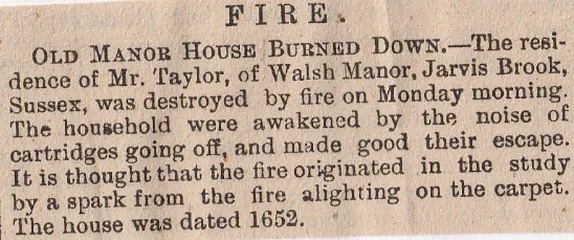
26/ Brighton Dome Suicide, December 1894
Superintendent Thomas Holloway was found dead in an office, almost beneath the organ at Brighton Dome. He had slit his throat in an act of self-destruction. He was an exceptional policeman and had been commended for bravery and also risen through the ranks due to his superb ability at police work. There was no letter left behind, so it remains a mystery as to why he committed suicide.
27/ Brighton, November 1905 (Murdered Child/Insane Nurse)
Emily Cason, a nurse at a Brighton nursing home, and afterwards declared to be insane by the doctor, had slit the throat of a five-month-old child. It was discovered in its cradle saturated in blood. Cason has been removed to the Workhouse Infirmary.
28/ Hove Murder/Suicide, November 1908
In the front room of a house at Westbourne Street, Hove was the dead body of a 40-year-old man and the bodies of his wife and child. A revolver was next to him. Later evidence suggests that the man was H.R.Wakley, an inspector in the Burma police. The couple rented two rooms at the premises and the child was only around a year old. Little is known about them, but the man’s strange behaviour had got the attention of the neighbours. Letters found there show that Wakley had premeditated the double murder and then to commit suicide. He had been asking friends if he could borrow some money as he was hard up and his pension wasn’t due for another six months or so. It is the financial situation, that is thought to have tipped him over the edge.
29/ Brighton Racecourse Suicide, August 1885

30/ Brighton, July 1851
Fifty-five-year-old James Wady killed himself by drowning because his 73-year-old brother had got hitched to an eighteen-year-old. His brother thought a certain property would be passed down to him, but now he was married it had scuppered his plans.
31/ Brighton, July 1851 (Long Suicide Note)
Another suicide in Brighton, this time by a lad from Shoreham who lodged at a beer shop in Gloucester Lane on the weekends, then on Monday he was found hanging in an outhouse. He was an opium fiend and in his hat, he’d left he’d written in a prayer-book. “Whoever finds my body, I will thank them to convey this book to Jane Nye, 23, Marine Parade, Brighton. Give her my dying love”. Jane was a servant he’d known for a few months and his letter to her read:
“For the last time, I take my pen to address. My hand shakes, and every vein in my body is well nigh bursting. Oh Jane! This is a very heavy trial indeed; and I little thought it would come to this. And now my dearest Jane, I must forever, bid you farewell. When this reaches you, the hand that writes it will be cold in death; and, Oh! my dear Jane, as a dying man, and about to enter the presence of an offended God, I implore you, I beseech you, to forgive me if at any time I have done or said anything to wound your feelings, pray forgive me. Strive to forget me, and forgive me. Pray, pray, do pray for your poor wretched Thomas. I know how this will grieve you. Be happy! May you meet with a partner for life that will make you as happy as you deserve. Oh Jane! I would to God I had been able to have married you; but it cannot be, and to live to see you the wife of another, I cannot, I will not.No, no.God bless you! God Almighty guard and keep you. Accept a dying prayer of your unhappy Thomas. Forget me, dear Jane. May we meet in Heaven. Farewell, farewell, dear Jane. Keep the little papers you have about you in your possession, also the prayer-book, for my sake. If I have offended you, forgive me. Pray, pray for me. You have been too kind, I am thankful for it. Once more, God Bless you, and God be with you. This is a hard trial, but I have sworn and do solemnly declare I will never love another. God bless you.”
32/ Woodbrook Farm, Chailey, near Lewes, June 1894 (Infant Remains)
A man was clearing out an ash-pit under an oven at Woodbrook Farm in Chailey when he raked out the skeleton of a child. The head and feet were intact but the remainder of the child was in a crumbling state. There are no hopes of identifying the infant.
33/ Eastbourne, (Two Die from Weird Car Crash), December 1915
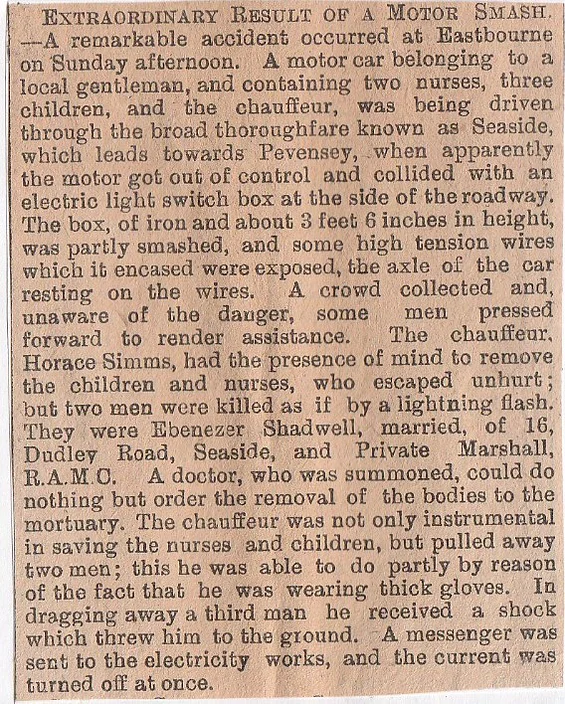
34/ Newhaven Murder, April 1893
A farmer found the body of a woman on the Downs near Newhaven, she had murdered. Her face had been smashed in with some stones that lay near the murder scene. The woman was around forty and had her arm raised, and extended across the face as if to protect herself from the attacker. Locals told police that they had seen the woman with a man, the previous day, and they were also noticed in a couple of pubs. There were some letters in her bag and they had come from her father, who lived in Plymouth. The man they described her as being with was sort of a tramp-like figure. A local shepherd heard arguing on the hills at around midnight near to the place the body was found. A tramp and his wife came forward to say that they were out with the other pair and the other man’s name was Job Taylor, from Wivelsfield.
35/ Hove Baths and Laundry Co., Brighton January 1904 (Lift Fatality)
A shocking accident has occurred at the lift at the Hove Baths and Laundry Co., in Brighton. The hand lift had been pulled up to the first floor when it gave way and two laundry girls went with it and landed on Frederick Washington. He was dead when extricated from the mangled mess and the two girls were rushed to hospital with cuts and bruises.They are both doing well. (Where was the Hove Baths Company?)
36/ Brighton, (Freak Accident) July 1830
In typical Victorian fashion, an old man had gone out on a pleasure-boat with a group of others and he took a couple of guns so he could shoot some birds. This person was Mr T.Scharnell from Brighton and at sixty-six years of age, not exactly very sprightly. A flock of guillemots honed into view so he picked up a gun, but by a million to one chance a rope caught the trigger of another and the gun exploded. His throat took the blast and it looked as though he’d been cut across it with a knife. He was rowed back to shore but died before they could reach a doctor.
37/ Crumbles Beach Landslip, Eastbourne, December 1872
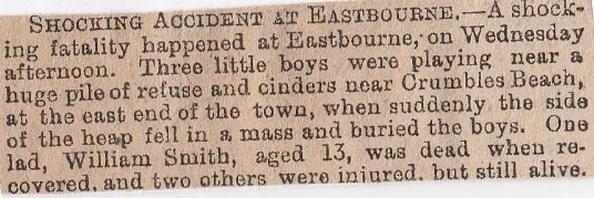
38/ Hellingly Accidental Hanging, April 1846
A fourteen-year-old boy by the name of Noakes, the son of a Hellingly farmer, met his end in an extraordinary manner. He was ploughing with his father and then went to get some straw from the loft. The father, not seeing his son for half an hour went to find him and saw the boy, or what he thought, to be in a sitting position.He asked him “What, Jim, are you asleep?”. He realised then that his son was hanging by means of a lantern rope to a beam. The boy was fond of swinging on the lantern rope, putting his head in a noose and holding on with his hands, above his head. “Deceased accidentally hung himself”
39/ Brighton Suicide, December 1862 (Caught Fiddling the Books)
The town of Brighton was abuzz with the rumour that the borough accountant, Mr Lewis Slight jun. had killed himself. He had resigned this post on Monday, due to allegations of the mismanagement of Pavilion money, said to be about £600. This was supposed to deal with it privately but it had been printed in a section of the local paper and thus it became public knowledge. Slight was apoplectic about it and he went to his bedroom one morning and hung himself with his sock. His wife, who was expecting their first child, is extremely vulnerable at the moment and may not survive. He was about forty-years-old.
40/ Eastbourne Charabanc Accident, June 1895

41/ Hailsham Bigamy Case, May 1855
This was supposed to be a case of bigamy, but with men going off and leaving her, then coming back, how can it be? The story is about Margaret Gravett and her first husband Stephen Richardson, and he was transported about thirty years ago, probably to Australia. After he had been gone about four years she thought he wasn’t coming back, so she married John Gravett in 1829 at Lewes. Then Richardson came back and claimed his missus again and she went to live with him. Then about twelve years ago (1843), Richardson again got transported for an offence, this time for fifteen years. A couple of years later she married an Eli Parsons at Ewhurst. So now she was getting done for bigamy, poor bugger!
42/ Brighton Railway Terminus Suicide, December 1893
A young lad at the Brighton Railway terminus went up to a policeman and said he had found a man hanging in the horse-box. On inspection, it proved to be true and he was cut down. He had a plaid suit on and was found hanging so that his knees nearly touched the ground. There was no identification on him or any letters or tickets, to help police gain a clue as to his identity.
43/ Elm Grove, Brighton, March 1908 (Father Shoots Children)
At a house in Elm Grove, Brighton a man named Ford who is a traveller was found dead with a gunshot wound to the temple. On the bed were his two children, Dorothy aged ten and Charles aged eight, both with bullet wounds to their heads. At Hospital they were in a precarious condition, but both alive. The mother said they all went to bed in a good mood last night, so there is no motive for the crime.
44/ Polegate Junction Child Murders, Eastbourne, December 1889
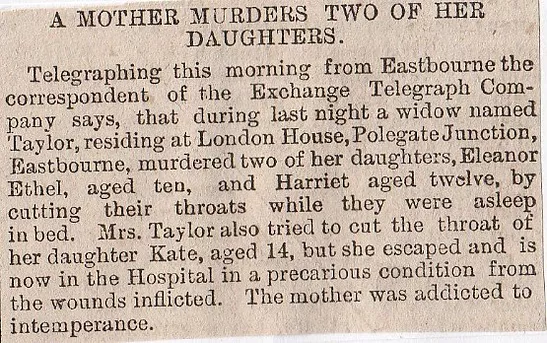
45/ Polegate Junction Child Murders, Eastbourne, January 1890
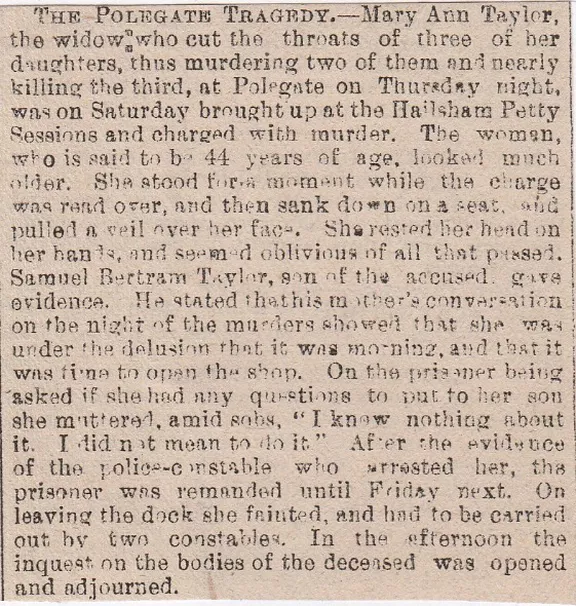
46/ Hurst Green Suicide Epidemic, October 1835
A fourteen-year-old daughter of a man named Lusted who runs a beer-shop in Hurst Green committed suicide by hanging herself in the attic. The father was out and the younger sister was the only other person on the premises. About eighteen months ago her mother threw herself down a well and it was this probably caused her to do the same. Hurst Green has had twenty-one suicides in the past twelve years.
47/ Brighton, June 1850 (Bathing Machine Accident)
Mr Lewen took his kids to Brighton, then went to the beach for a paddle and a swim. Two of them, one a nine-year-old girl and the other a girl of seven years of age, left the bathing machine while the other children got into their swimming cossies. They climbed on the wheels and somehow the driver got the go-ahead to take the machine into the sea. They both went along with the machine as it moved, but one let go while the other one clung on. She was rotated and the wheel passed over her head and blood came out of her ears. The child was unconscious. (Did she live?)
48/ Brighton, February 1892 (Girl Drowns)
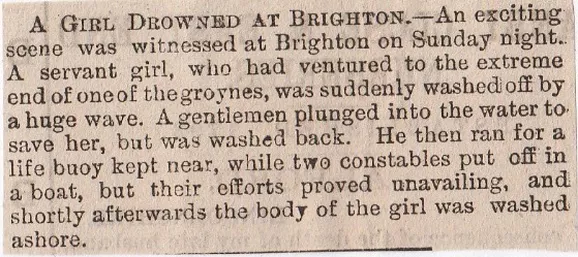
49/ Eastbourne Murder/Suicide, December 1901
The landlady and some lodgers at 64, Ceylon Place, Eastbourne, heard shots coming from the front room of which a man and woman resided in. A police officer on the beat ran to the scene and tried to open the door, which had been locked. He opened a window and got in, where he found a man lying on the ground with two bullet wounds in his chest. The woman was sat in a chair, with three or four bullet wounds. The woman was rushed to the hospital where doctors are hopeful that she will recover. It is believed the man shot the woman, then committed suicide. The woman is a lot younger than him and they are thought to be lovers, and while at the house she uttered the word “Violet”. He was later identified as Charles Osborne, about nineteen and a painter from Askew Crescent in Shepherd’s Bush. The woman is Alice Funnell who is the daughter of a tobacconist at High Street in Hailsham.
50/ Brighton, October 1885
A fisherman named George Guayden while assisting to bring a fishing smack into Brighton yesterday morning was washed out of the boat by the heavy waves, and before assistance could be rendered, he was drowned.
51/ Oxford Music Hall Fatality, Brighton, January 1882
A Chinaman, Ali Ling Look, was to be charged along with his wife with causing the death of the boy named George Smyth at the Oxford Music Hall in Brighton. They fired a cannon during their act and the paper pellet inside the cannon killed the boy. They were to be tried for manslaughter and when the verdict of “Not Guilty” was read out, there was a round of applause and Look said “I thank you my Lord” in broken English.
52/ Laughton near Lewes, (Murder/Suicide) January 1885
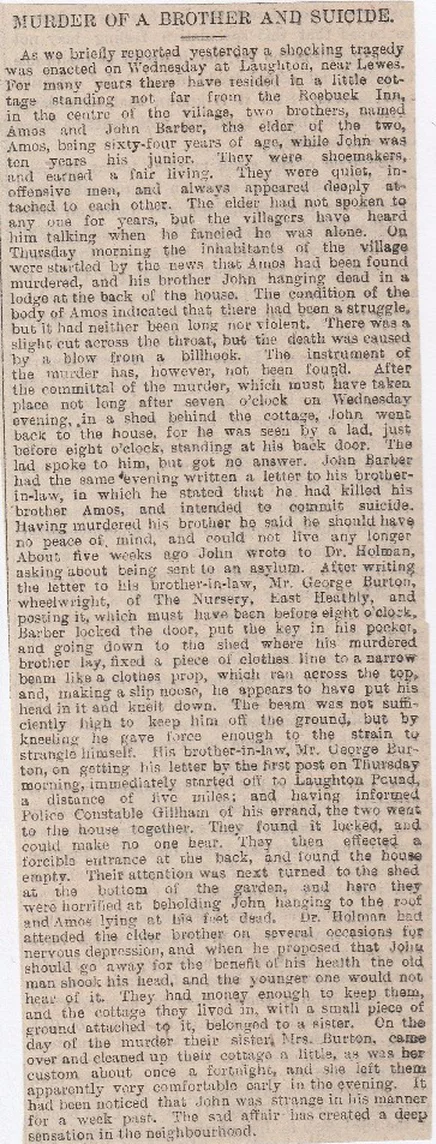
He was later identified as Gustave Bernhard Fischer, a 55-year-old florist from Belvedene Grove, Wimbledon.
BEACHY HEAD – Not only is Beachy Head England’s most popular suicide spot but also ranks as third in the world, only Golden Gate Bridge and Aokigahara Woods in Japan rank worse.These are the rest I found in the Victorian era papers.
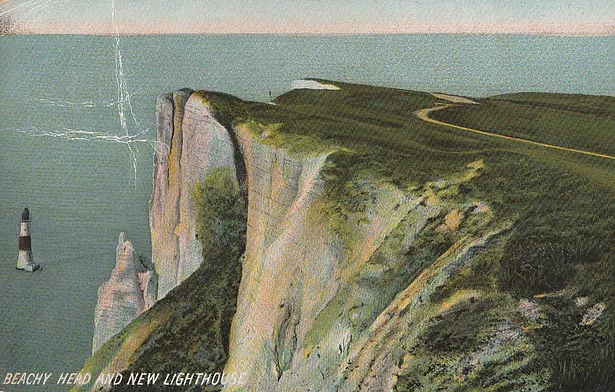
53/ Beachy Head, September 1884
A man’s body was discovered in some brushwood on the South Downs near Beachy Head. He was identified as Dr Charles Palmer a surgeon from Yarmouth, visiting the area. There were surgical instruments nearby, which explains the cuts to the arteries in the groin. This was the skilful work of a surgeon and foul play was ruled out.
54/ Bell Lighthouse, October 1882

A young lady was walking along the cliff at Beachy Head when a gust of wind blew her hat off, she looked over the edge to see if it was there when she toppled over and fell over four-hundred feet.
55/ Beachy Head Mystery, April 1903
About a quarter of a mile west of Beachy Head, the body of a man was discovered. Aged about mid-forties, medium height with greying hair and a bald patch on top. The mouth was stuffed with tissue paper and his lower jaw and upper arm were fractured, probably from the waves washing the body against the rocks. He had on a dark suit, grey overcoat with velvet collar. He had been in the water approximately twenty-four hours.
56/ Off the coast near Beachy Head, April 1885
The Brigantine Charles George of Cowes, collided with a steamer off Beachy Head. The former sank and the master and mate were drowned.
57/ Beachy Head, (Fatal Fall) April 1892

58/ Beachy Head, April 1887
The body of a teenage girl was discovered on the rocks on the west side of Beachy Head and it is thought that she fell from the cliff where her umbrella was found. She was identified as a sixteen-year-old Eliza Legge from Reading and she fell five-hundred feet.
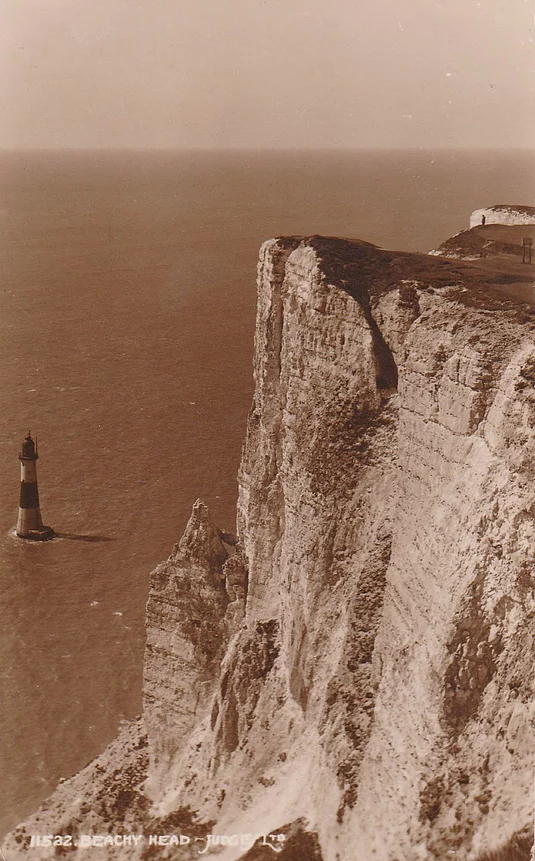
59/ Beachy Head, September 1902
A fatal accident occurred at Beachy Head when James Taylor, a seventeen-year-old decided that after a walk along the beach and taking some photo’s, he thought it would be quicker to climb the cliffs. He and some companions proceeded to climb, when, as a witness stated, the coastguard began to shout at them. The witness looked over the cliff at who the coastguard was bellowing at and saw Taylor and a couple of mates standing on a ledge about thirty feet from the top. A rope was lowered for them and two were pulled up, but when it was Taylor’s turn he slipped and fell over three-hundred feet.
60/ Beachy Head, April 1914
Two lads who were delivering the post to the lighthouse at Beachy Head saw a bloke fall off the cliff, a height of some five-hundred feet. The body landed on a ledge and was later recovered by a group of coastguards. The man was Arthur Atlee, a thirty-five-year-old single man who worked in a chemist’s.
61/ Beachy Head, May 1899
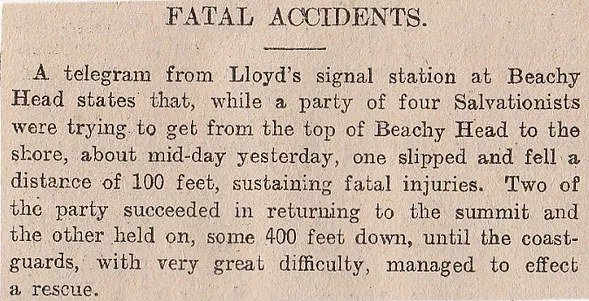
62/ Beachy Head, October 1906
A young man by the name of Edward Barrow who was living in between the towns of Eastbourne and Sutton in Surrey was found by police on a ledge of the cliff at Beachy Head. The corpse was badly decomposed and mutilated and had been there about two weeks. He was about one-hundred feet from the ground on the ledge.
63/ Beachy Head, (Two Tragedies) January 1905
The first was the sad case of Lavinia Relf aged twenty-two, whose naked body was found at the bottom of the cliff. It is reckoned that she stripped naked and then jumped off the cliff, scattering her clothes as she fell. She told her father she thought she was going mad and had been in a strange mood for quite a while. She fell about 350 feet and left her purse at the summit with a card in it, which was to be posted to an address in London. – The next was a former Mayor of Wallingford in Oxfordshire, Mr James Morty, who was discovered on the foreshore below Beachy Head, where it is almost five-hundred feet in height. His wife said he went for a walk with the dog after reading about the suicide of Relf (above) and he wanted to see the spot where it happened. It is suspected of being an accident.
64/ Beachy Head, August 18th, 1885
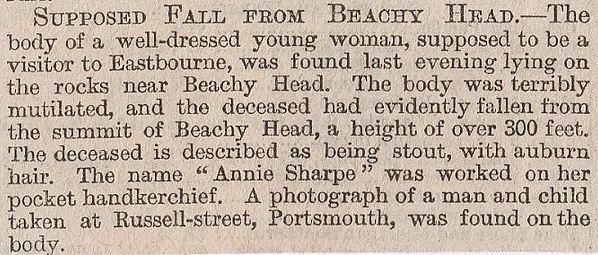
65/ Beachy Head, August 20th, 1885

66/ Beachy Head Suicide, May 1906
This is a rather sad tale of a suicide at Beachy Head, by the lady Emily Kate Nash aged thirty-four, who was living at 41, Blenheim Gardens in Willesden Green. The husband said that she had anaemia of the brain and was getting treated for it. She slipped out of the house but the husband followed her. She went to Willesden Station, then went by tram to Baker Street Station. The husband stopped following her. Nash complained of severe headaches and pronounced she’d be happier dead. Her brother was told by her that she had “lost her love for her children”. When she stood on the edge of Beachy Head people were screaming at her to stay away from the edge, but a few minutes later there was a muffled scream and she had fallen the four hundred and eighty feet to her death.
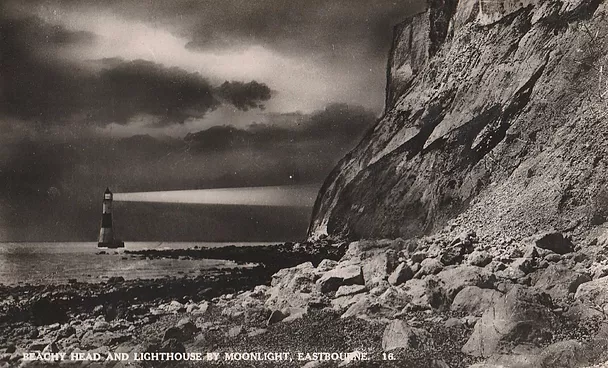
67/ Beachy Head, November 1915 (Killed on Honeymoon)
At the inquest into the death of his wife, Lieutenant StJohn Sampson described how Isabel Mackenzie Sampson died. They were married at Edinburgh last week, then came down to Eastbourne on Monday. He took her for a drive in an American two-seater motor-car. She was fascinated with the self-starter motor and even tried it herself, stating “There, I know how to do it don’t I?”. They were on the cliff top with the car about twenty yards from the edge and she went back to the car, the next time he looked there was nothing there. He thought he’d left the brake off or the gear on.
“I realised that she had gone off the cliff and I think I became totally incapable. As far as I remember I ran to a cottage. I dared not go back and look over the cliff”. The cottage owner, Dorothy Hills said he arrived in a state of collapse and sat him on the sofa. It was judged to accidental death due to her starting the motor unintentionally.
68/ Beachy Head Suicide, August 1906
The way this woman killed herself at Beachy Head is slightly unnerving, to say the least. Laura J.Allchorn, a forty-four-year-old from Seaford had been unwell since the birth of her child a few months ago. She had been staying with friends near Eastbourne but slipped out without anyone noticing. She went to Beachy Head in a cab and kept asking the cab driver about the cliffs. The cab-man told a coastguard that she should be watched and he did so. A family from London saw her near the cliff edge and tried to coax her to come away from there, but she simply glared at them, then gently rolled over the edge and a 350 feet drop below onto a ledge.
69/ Horrific Accident near Lewes Railway Station, February 1866
70/ Dreadful Accident at Rottingdean Cliffs, near Brighton. April 1866
71/ Strange Death in Brighton. April 1866
72/ Fatal Accident in Eastbourne, May 1866
73/ Couple Suffocated in Brighton (Black Lion Street) September 1904.
74/ Acrobat’s Fatal Fall From Tightrope, Hastings. June 1905.
75/ Young Lady Killed at East Dean, near Eastbourne. June 1906
76/ Double Fatality near Hampden Park Station, Eastbourne. November 1906
77/ Teenage Girl Poisons Herself, Brighton. December 1880 (Laudanum plus a suicide note)
78/ Fatal Boating Accident, Hastings (Four Drowned) 14th October 1880
A sad accident occurred to a fishing party off Hastings on Tuesday afternoon. Thomas Rodwell, William Lindsay, Mr Docwra, a tradesman of Robertson Street, with two boatmen named Swaine and Burton, went fishing in Mr Howell’s yacht, the “Minstrel”, and when about a mile and a half off the East Cliff a sudden squall capsized the boat. The accident was witnessed by the crew of a fishing smack, which immediately bore down upon the yacht; but they only succeeded in saving the life of Burton and securing the body of Mr Docwra.
Friday, 15th October 1880. (Inquest)
Tuesday, 19th October 1880
A coroner’s inquest was held at Hastings yesterday evening on the body of the boatman Swain, who was drowned by the capsizing of the “Minstrel”. The body was recovered while the yacht was being raised to the surface. It was stated the deceased was a first-class waterman, but could not swim. He had held on to the bowsprit when the vessel was sinking. The bodies of Mr Rodwell and Mr Lindsay have not been recovered. The jury returned a verdict of “Accidental Death”.
